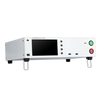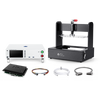Why we do IoT

Our mission at Blue Clover Devices is to leverage the power of IoT to eliminate waste in all its forms and make a more beautiful world.
The most flagrant form of waste is the design, production, shipping, and fulfillment of a defective product. With the knowhow that mankind has amassed over the years, it's breathtaking how often we shuffle around horrible products that should never have been made in the first place.
Let me give you an example. Recently, my wife and I purchased a wall clock online, which I hung up in our den. About ten minutes later, the second hand stopped moving. With some mild cursing, I replaced the AA battery with a new one and it functioned normally—until it didn’t. After another ten minutes the second hand stopped again. Perhaps there was a simple fix, but perhaps there wasn’t.
The fact of the matter is that somebody spent hours designing this clock. Tooling was made, production lines were set up, and someone (supposedly) did Q.C. on it before it was sent to a warehouse. We bought it and an express service rushed it over to us. I hung it up on the wall and yet IT DOES NOT TELL TIME!
This is not a minor defect. Could anyone dispute this is a waste? How could IoT change this outcome?
Well, if this clock had been an IoT clock, then it could have reported a failure to the cloud, about which the manufacturer could be alerted immediately. This would have happened before we bought it, and the defect would have been corrected during design or production, long before we even came into contact with it.
Even a fully-functioning product can generate waste. Last year we began making MFi-approved lightning cables, which we purchased a lot of expensive equipment to do. Our strategy was to get best-in-class equipment to help overcome our relative inexperience with managing this particular type of machinery. For example, we bought an ultrasonic welder from Switzerland with an impressive track record. These welders, which are fairly sophisticated, essentially have a PC running inside of them. In theory, according to the manufacturers, I could go on the internet from home to see how many ultrasonic welds took place on their machine that day. But in practice, it did no such thing.
I have no qualms about the welding capability of this product—these machines have served valiantly. However, if you wish to adjust the machine settings, you are definitely going to have to walk up to the machine and sift through some touchscreen menus to find out how it is configured. If you need help from their technician, he or she will come to the factory to check it out, but as for seeing summary data from home, this is a fantasy. While a reliable product, this ultrasonic welder could be improved substantially with the addition of practical IoT functionality to eliminate the effort wasted in servicing it.
Yet another reason for IoT is its ability to offer usage of a device via a subscription model instead of selling it outright. When washing machines were first manufactured they were welcomed for their time-saving utility, but were too expensive for a middle-class home to afford. To overcome this barrier, the manufacturers delivered the machine to the home with a coin slot on it so that they could make it a pay-per-use service. (The drawback was that they had lots of coins to deal with!)
Today this same situation could be handled with IoT. Let’s say Whirlpool has a line of IoT washing machines called “Whirlpool Air.” When you purchase this machine you don’t pay $500, you register effortlessly through the mobile app and then pay $15 per month. The app tells you things like the number of loads you’ve washed with this machine and of course has the user guide so you don’t need a paper one. Over the years, by being such a loyal customer and washing so many loads of laundry, you become a Whirlpool Gold customer. When your washing machine breaks down, Whirlpool sends someone there to repair it, free of charge. Years later when it breaks again, they send you a trade-in offer to deliver a new and more efficient machine, again free of charge. Such a deal! As you remain a loyal member of the Whirlpool family, your son notices that the coin-operated washing machine at college is a Whirlpool; since your family has Whirlpool Gold status, he can use that for free, too. And guess which machine he’ll lean toward when it comes time to furnish a home of his own? IoT enables companies to sell a genuine sustainable service instead of trying to up-sell dizzying features that few want or even understand.
The final reason we focus on IoT is because it perfectly suits us. We are deeply rooted in two offices: one in San Francisco and one in Shenzhen. With this intercontinental structure, we can draw from the software savvy of the Bay Area and the hardware expertise of Shenzhen. These two offices are closely interconnected, with meetings and travel regularly taking place between them. This is important for IoT, because there are a lot of different software and hardware elements swirling around each product design. It can be tricky to keep everything working smoothly together, but our agile team of 150 people excels in this IoT world through teamwork and dedication to our clients.










Leave a comment